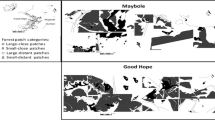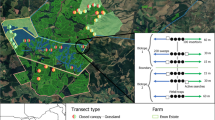Abstract
While there has been much debate on the role of landscape corridors or linkages for animal movement and residency, there is little information on their role in maintaining ecological associations. We assess here the arthropod assemblages on flowers, seed heads and leaves of indigenous plants in a network of remnant grassland corridors across an alien pine-planted landscape in southern Africa. The results showed that the arthropod-plant (flowers, seed heads and leaves) associations remained, and were mostly quantitatively similar throughout the network of corridors. Narrow corridors (20–100 m wide) deep within the plantation-grassland mosaic still had high biodiversity value. The most threatening factor to flower-arthropod associations was disturbance, particularly cattle grazing. That the host plants were actually present was, in itself, an indicator that disturbance nevertheless was low. The associations are only lost when the plants are lost, and not when the plants are present but under some disturbance pressure. Although these corridors, which amount to about a third of the total area, mitigate the effects of pine afforestation, they can also be conduits for heavy human impact. This means that these corridors, even narrow and deep ones, are only of maximum value when there is minimal anthropogenic impact.
Similar content being viewed by others
References
A.F. Bennett (1999) Linkages in the Landscape IUCN GlandSwitzerland and CambridgeUK
P.-E. Betzholtz (2002) ArticleTitlePopulation structure and movement patterns within an isolated and endangered population of the moth Dysauxes ancilla L . (LepidopteraCtenuchidae): implications for conservation J. Insect Conserv. 6 57–66 Occurrence Handle10.1023/A:1015794522642
P. Dennis (1997) Impact of forest and woodland structure on insect abundance and diversity A.D. Watt N.E. Stork M.D. Hunter (Eds) Forests and Insects Chapman and Hall London 321–340
N.M. Haddad (1999) ArticleTitleCorridor and distance effects on interpatch movements: a landscape experiment with butterflies Ecological Applications 9 612–622
N.M. Haddad (2000) ArticleTitleCorridor length and patch colonization by a butterfly, Junonia coenia Conserv. Biol. 14 738–745 Occurrence Handle10.1046/j.1523-1739.2000.99041.x
G.R. Hess R.A. Fischer (2001) ArticleTitleCommunicating clearly about conservation corridors Landscape Urban Plan. 55 195–208 Occurrence Handle10.1016/S0169-2046(01)00155-4
C.J. Hill (1995) ArticleTitleLinear strips of rain forest vegetation as potential dispersal corridors for rain forest insects Conserv. Biol. 9 1559–1566 Occurrence Handle10.1046/j.1523-1739.1995.09061559.x
R. Kinvig M.J. Samways (2000) ArticleTitleConserving dragonflies (Odonata) along streams running through commercial forestry Odonatologica 29 195–208
N.A. Mawdsley S.G. Compton R.J. Whittaker (1998) ArticleTitlePopulation persistencepollination mutualismand figs in fragmented tropical landscapes Conserv. Biol. 12 1416–1420 Occurrence Handle10.1046/j.1523-1739.1998.97243.x
M. Mönkönen M. Mutanen (2003) ArticleTitleOccurrence of moths in boreal forest corridors Conserv. Biol. 17 468–475 Occurrence Handle10.1046/j.1523-1739.2003.01414.x
I. Oliver A.J. Beattie (1996) ArticleTitleInvertebrate morphospecies as surrogates for species: a case study Conserv. Biol. 10 99–109 Occurrence Handle10.1046/j.1523-1739.1996.10010099.x
S.R. Pryke M.J. Samways (2001) ArticleTitleWidth of grassland linkages for the conservation of butterflies in South African afforested areas Biol. Conserv. 101 85–96 Occurrence Handle10.1016/S0006-3207(01)00042-8
S.R. Pryke M.J. Samways (2003) ArticleTitleQuality of remnant indigenous grassland linkages for adult butterflies (Lepidoptera) in an afforested African landscape Biodiv. Conserv. 12 1985–2004 Occurrence Handle10.1023/A:1024103527611
O.L. Sutcliffe C.D. Thomas (1996) ArticleTitleOpen corridors appear to facilitate dispersal of ringlet butterflies (Aphantopus hyperantus) between woodland clearings Conserv. Biol. 10 1359–1365 Occurrence Handle10.1046/j.1523-1739.1996.10051359.x
J.F. Thorne (1993) Landscape ecology: a foundation for greenway design D.S. Smith P.C. Hellmund (Eds) Ecology of Greenways University of Minnesota Press Minneapolis, USA 23–42
H.J.W. Vermeulen (1994) ArticleTitleCorridor function of a road verge for dispersal of stenotopic heathland ground beetles Carabidae Biol. Conserv. 69 339–349 Occurrence Handle10.1016/0006-3207(94)90433-2
M.S. Warren (1985) ArticleTitleInfluence of shade on butterfly numbers in woodland rides with special reference to the wood white Leptidea sinapis Biol. Conserv. 33 146–164 Occurrence Handle10.1016/0006-3207(85)90101-6
B.C. Wood A.S. Pullin (2002) ArticleTitlePersistence of species in a fragmented urban landscape: the importance of dispersal ability and habitat availability for grassland butterflies Biodiv. Conserv. 11 1451–1468 Occurrence Handle10.1023/A:1016223907962
Author information
Authors and Affiliations
Corresponding author
Rights and permissions
About this article
Cite this article
Bullock, W., Samways, M. Conservation of Flower-arthropod Associations in Remnant African Grassland Corridors in an Afforested Pine Mosaic. Biodivers Conserv 14, 3093–3103 (2005). https://doi.org/10.1007/s10531-004-0379-7
Received:
Accepted:
Issue Date:
DOI: https://doi.org/10.1007/s10531-004-0379-7




